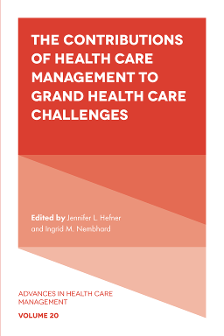
Index
The Contributions of Health Care Management to Grand Health Care Challenges
ISBN: 978-1-80117-801-3, eISBN: 978-1-80117-800-6
ISSN: 1474-8231
Publication date: 6 December 2021
Citation
(2021), "Index", Hefner, J.L. and Nembhard, I.M. (Ed.) The Contributions of Health Care Management to Grand Health Care Challenges (Advances in Health Care Management, Vol. 20), Emerald Publishing Limited, Leeds, pp. 283-288. https://doi.org/10.1108/S1474-823120210000020017
Publisher
:Emerald Publishing Limited
Copyright © 2022 Jennifer L. Hefner and Ingrid M. Nembhard. Published under exclusive licence by Emerald Publishing Limited
INDEX
- Prelims
- Section 1 The Challenge of Caring for Vulnerable Populations
- Emergent Homecare Models Are Shaping Care in England: An Ethnographic Study of Four Distinct Homecare Models
- Aligning Health Care and Social Services for Patients with Complex Needs: The Multiple Roles of Interorganizational Relationships
- Section 2 The Challenge of Maintaining the Workforce – Retention and Equity
- The Challenge of Employee Retention in Medical Practices across the United States: An Exploratory Investigation Into the Relationship between Operational Succession Planning and Employee Turnover
- An Exploration of Gender Bias Affecting Women in Medicine
- Section 3 The Challenges of Translating Innovation into Practice
- Technological Change and Frontline Care Delivery Work: Toward the Quadruple Aim
- Improving Training Motivation and Transfer in Hospitals: Extension of a Conceptual Model
- Section 4 The Challenge of Organizational Sustainability
- Hospital Ownership and Financial Stability: A Matched Case Comparison of a Nonprofit Health System and a Private Equity–Owned Health System
- NCHL's “Best Organizations for Leadership Development” Program: A Case Study in Improving Evidence-based Practice through Benchmarking and Recognition
- Section 5 The Challenge of Pandemics for Patients, Workers, and Practices – Lessons from Covid-19
- Impact of COVID-19 on Primary Care Practice Sites and Their Vulnerable Patients
- Even Superheroes Need Rest: A Guide to Facilitating Recovery from Work for Health-care Workers during COVID-19 and beyond
- Index